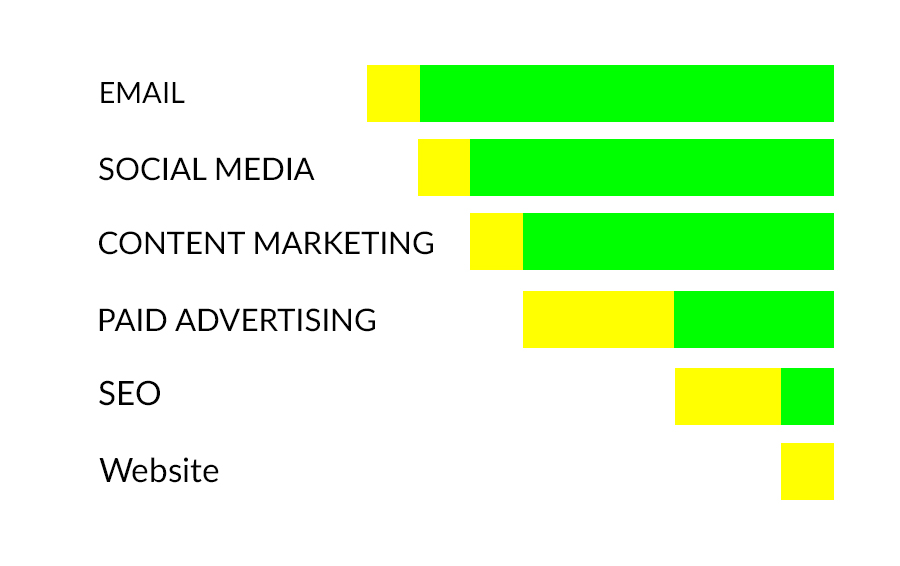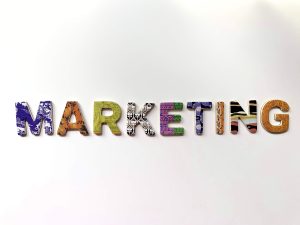What is Digital Marketing?
What is Digital Marketing? Well…(deep breath)…it’s confusing…but not as confusing as you might think.
In this post, we’ll do our best to explain all the different areas of Digital Marketing and how they fit together. We’ll also explain why you should understand them all and where they fit in your priority list.
What is Digital Marketing?
Digital marketing is the marketing of products or services using digital technologies via digital mediums.
It’s a beast and together, we’re going to tame it.
For the technically challenged this might seem as if you’re standing at the foot of Everest. But fear not, we’re going to explain it the best we can. How the pieces fit together For many businesses, digital marketing starts with their website. The website is critical to get right. The website converts a visitor who is looking for a service or a product into a customer. We’ll discuss the transition process later in this article when we talk about website optimisation, but for now, all we need to consider is getting more people to find the website.  As you can see from the image above, everything starts with the website and finishes with email marketing. So let’s discuss why and how the website plays such a crucial role in digital marketing and what tools are available for us to use to reach a larger audience.
As you can see from the image above, everything starts with the website and finishes with email marketing. So let’s discuss why and how the website plays such a crucial role in digital marketing and what tools are available for us to use to reach a larger audience.
Websites
You’re probably aware that there are countless digital marketing tools available on the internet and at some point, you’ve been encouraged to use them all. Facebook, Google My Business, Instagram…the list goes on. But if you think about it, all of these various tools are connected by one thing…
The internet.
But what is the one thing that separates a website from Facebook, Google My Business, Instagram and all the others? Ownership. Facebook or Google can make a change tomorrow and you would be powerless to do anything about it. Nobody can change your website without your consent. You have control over your website and if your website is your shop window, your shop, your everything, then your website is your most powerful weapon. Everything starts at your website.
So you have a website. Even if it is just one page and has a few images on it, with a little content, it is still a website. The chances are though, that it will not attract large volumes of traffic, not yet anyway.
SEO
SEO refers to Search Engine Optimisation and it is the first step in driving traffic to your website.
Google is a search engine, so are Bing and Yahoo. To optimise for search engines means that you are making changes to your website so that these search engines know what your site is all about. It does this so that it can show your website to the right people at the right time. This is called relevancy. So if you sell widgets in Scotland, you would like your website to show up when somebody searches for ‘Widgets in Scotland’.
With the website optimised for search engines, organic visitors will start to find the website but you will still need to drive more traffic to your site. Google My Business You might have performed a Google search before and seen a list of companies show up on a map with their phone numbers and contact details. Showing up in those business results adds a little credibility. It tells the visitor that you are a genuine business. Internet shoppers are far more likely to buy from a business with credibility.
With Google My Business set up correctly, you should see a little more traffic coming to your website. Your organic reach has grown. You’re ready to take the next step, but first of all, you need to set yourself up with some way of measuring your success.
Google Analytics
Google Analytics (GA) is Google’s free tool that, when set up correctly, will record how many visitors your website gets, when they visit, how old they are, what browsers they use, and more. GA will even show you what people do when they are on your website. What pages do they visit and when do they leave?
These are all tools that you can embrace. If 80% of your visitors leave after ten seconds, then either your website doesn’t give the right information to the right people, or it gives the right information but you’re attracting the wrong people. This gives us an insight into areas of improvement.
If Analytics is just too much for you, then talk to a Digital Agency. They’ll be only glad to help and translate the information for you.
So now you have a website. It’s optimised so you’re seeing organic traffic and you have GA set up so you measure the traffic.
Now what?
Start measuring. Record how many visitors you get, how long they stay, and what your sales or enquiries (conversions) look like from your website. You’re going to need this information as a baseline to work from, so it’s a good idea to do this every week. The more data you have, the better decisions you will be able to make.
Now that you have some measurements in place, let’s drive some traffic to your website.
Paid Advertising
Only when you are set up to succeed with a website that converts visitors to customers and have tools in place to record data should you consider paid advertising.
Paid advertising is arguably, the best way to send targeted traffic to your website.
Note the use of the word, targeted.
With most paid advertising platforms, such as Google, Bing and Facebook, ads can be targeted at various demographic groups. These include:
- Location.
- Age
- Gender
- Interests
- Behaviours
With a reasonable budget, a business can design ads and place them in front of the target audience. This means that people who should not be interested in your product or service, will not see the ad. This improves relevancy and in some cases, can reduce the cost per click.
The term paid advertising encompasses a range of practices that generally refer to different areas of focus. Most platforms allow advertisers to optimise their ads for direct sales or retargeting.
A direct sales ad can be created to draw visitors to the website, however, a retargeting campaign can then be created to target the visitors who visited the website but did not make a purchase or make an enquiry.
The tools can be used in conjunction with each other and this approach falls in line with the ‘7 Touches of Advertising’ theory.
Paid advertising, when done well, is a great way to bring visitors to your website. However, your efforts should not stop there.
Content Marketing
Most websites have content. If that content is created with a plan in mind, it can produce some incredible results. Content marketing often comes in the form of a blog.
A blog is good for many reasons:
Greater SEO
A well-written and carefully planned blog can attract new visitors to a website. Each blog is an opportunity to increase your relevance in search engines. For example, typically, a single web page can only really be optimised for one or two terms. These are usually broad terms with the highest search volume for that particular industry. A website that sells gardening tools, for example, should not optimise its home page for ‘lawnmower sale’, it should be optimised to reach the entire gardening market. A term such as ‘London gardening supplies’ might be more appropriate for a home page.
However, a blog allows a website owner to have a dedicated page relating to a particular term or subject. Let’s use the same example of a gardening supplies company. The home page may be optimised for a general catch-all phrase. The individual product pages may be optimised for that particular product. But the blog can bring in a much wider audience. A single blog article can be optimised for the term, ‘Revive a dead lawn’ or ‘How to prune a rose’.
In short, more pages that are optimised will increase the number of visitors a website gets organically.
Industry Leadership
A blog article can also demonstrate to a target market that the content creator knows what they are talking about. They are industry leaders. A well-written and executed blog that is released regularly will be received well. In fact, a well-written blog can end up being the source of all information for some people which then means that when they want to buy a product or use a service, they don’t even have to think about where to turn. They already trust the website because they have been reading their blog articles.
Blog articles can be shared on social media platforms, and by email and can be found organically. If an article is well-written, it will attract visitors for a long time. It can turn a single-page website into a hundred pages of optimised content.
Factor in the optimised website we discussed earlier. Imagine if that website had a 1/10 conversion rate. When your website is set up to convert, all you need to do is drive the right traffic there. By creating industry-related content, the opportunities are endless.
Social Media
Social media is a huge part of today’s marketing toolkit. We won’t go into every platform here, we’ll cover these in separate articles as they deserve a full explanation and each platform is different. However, the reasons social media marketing should not be overlooked are as follows:
Social media is a great place to reach a wider audience. Think about it, if just one of your customers shares one of your helpful posts on cleaning, all of their friends will see your branding. Further, there’s a good chance that the friends that see that post and show an interest will already know that you are a trustworthy company. It’s called social proof and best of all, it’s free.
Social media is a great way to stay in touch with your regular customers. Just because they signed the dotted line doesn’t mean they will stay a customer forever. But if your customers see you post regularly, they will be reminded to book your service. Over time, as they read more of your posts, they will learn more about you, (which is a good thing).
The idea is to be the name on the tip of your audience’s tongue when they think of hiring a cleaning service. Once again, it’s free and only takes a few minutes per day. That’s not a bad investment.
Email Marketing
Remember at the very beginning of this article, we discussed about how a website is the only platform that belongs to a business. It’s the only platform a business owner has full control over and that’s why it is the single most important tool in the digital marketing toolkit.
However, there is one more tool that isn’t really a platform, but it does belong to the business.
An email list.
If the thought of developing an email list and having to send out emails every week, fortnight or month really bothers you, then perhaps this will change your mind.
Social media platforms change almost every month. Paid advertising platforms change too. The only constant is your website and your email list. If all other platforms were removed, what would you be left with?
A single email to a well-garnered email list at regular intervals is one of the best ways to ensure your customers know you still exist and they are aware of your latest deal.
We’ll be releasing an in-depth article on email marketing so we won’t go into too much detail here, but as a business owner, you should be at the very least looking into creating an email list.
A weekly email full of helpful tips, testimonials and offers can be the difference between a good and a bad week.
There are techniques that should be used to take on email marketing so look out for our article, but there’s nothing stopping you from subscribing to other email newsletters to see what people say. Find the ones that resonate with you and ask yourself why that is.
Summary
This has by no means been a total overview of the entire set of digital marketing tools. However, there are a few key takeaways.
Your website is the single most important tool you own. make sure it converts, then use supporting digital marketing tools to drive the right people there.
Use Google Analytics to measure the results of the changes you make. Start measuring as soon as you can. Remember, the more data you have, the better decisions you can make.
At DBS Digital, we provide Digital Marketing Services such as PPC Advertising and SEO Services so you can put your mind at ease and watch your business engagement and traffic increase. Our dedicated team is here to help. To learn more, make to contact us today.
Sign up to our newsletter
Get regular hints, tips and updates on internet marketing and web design.
Related Articles
Why Your Marketing Is Key To Surviving Tough Economic Times
Henry Ford once said “The man who stops advertising to save money, is like the man who stops a clock to save time”. Stopping marketing during tough economic times is something some businesses opt for as a quick way to save money in the short term and because they simply panic. This is natural of…
Read More5 Important Marketing KPIs to Measure Your Progress
Key performance indicators (KPIs) are used to track the effectiveness of business and department activity and measure individual and overall success. Different departments or areas of business have their own targets and strategies, and as such should have different KPIs. KPIs provide targets, milestones and insights to help motivate and educate your team so that…
Read MoreWhat is Conversion Rate Optimisation
Conversion Rate Optimisation sounds like a marketing buzzword. Maybe next year there will be another phrase in circuit. However, the fact is that Conversion Rate Optimisation is a requirement that is here to stay and one that business owners should pay attention to. What does Conversion Rate Optimisation mean? Before we discuss how we can…
Read More




